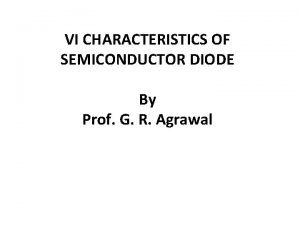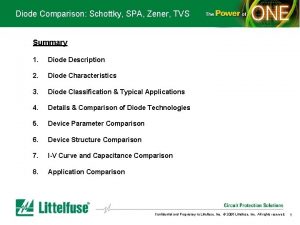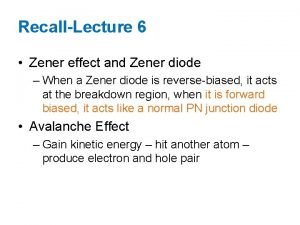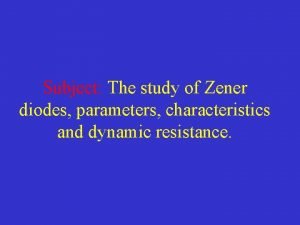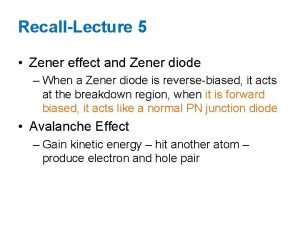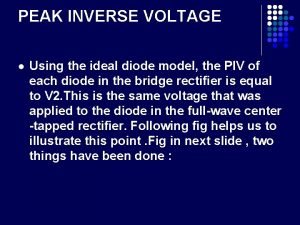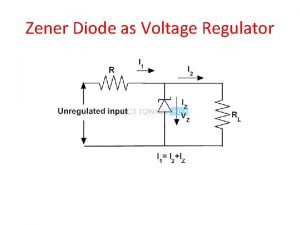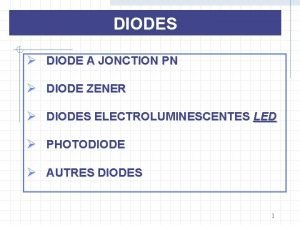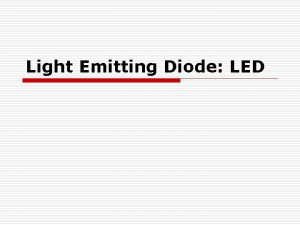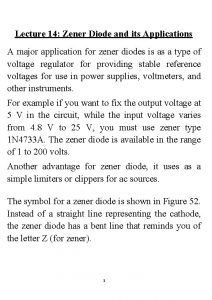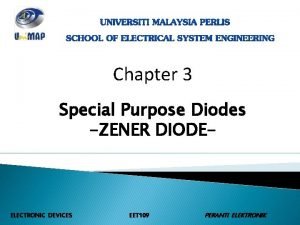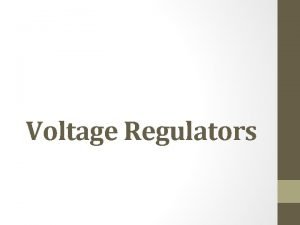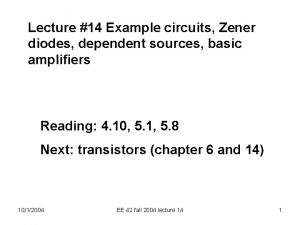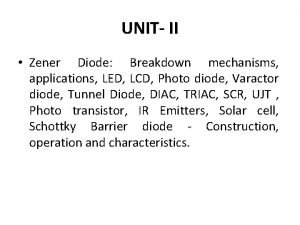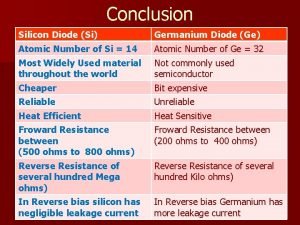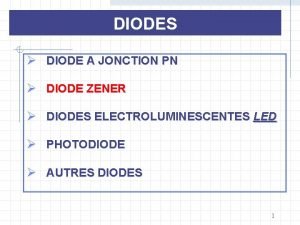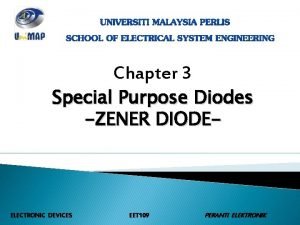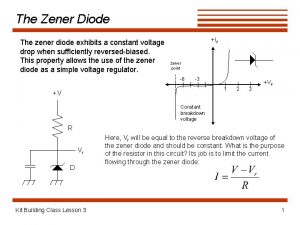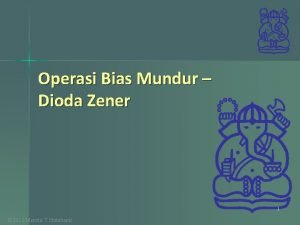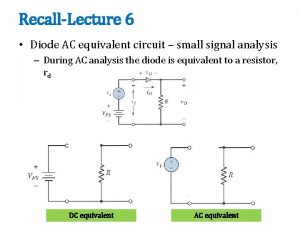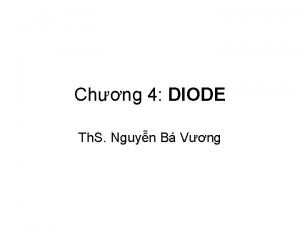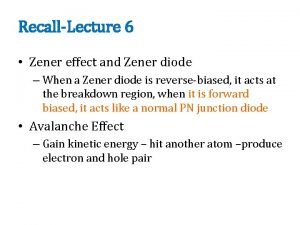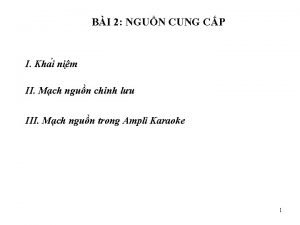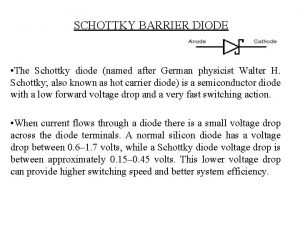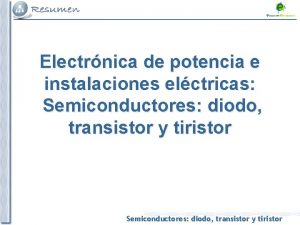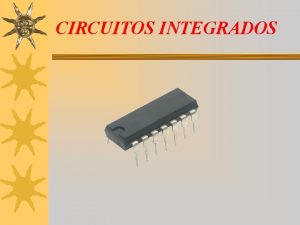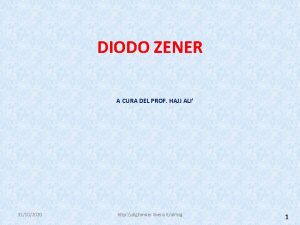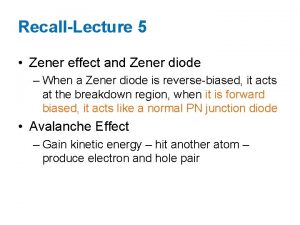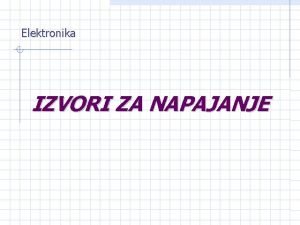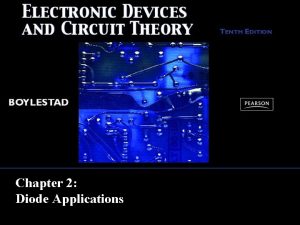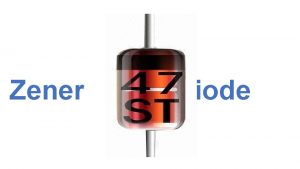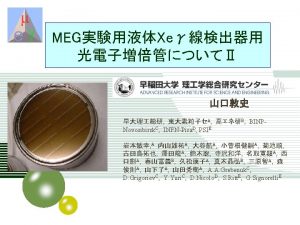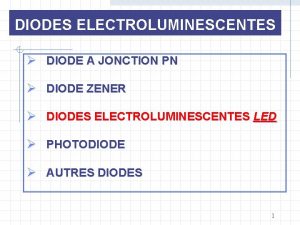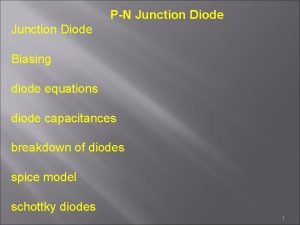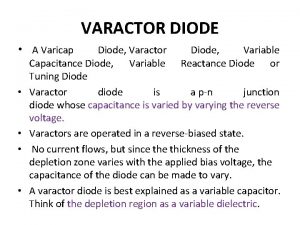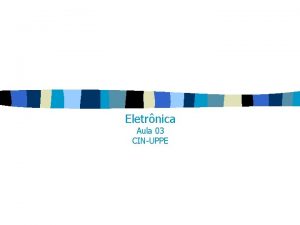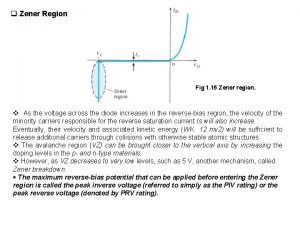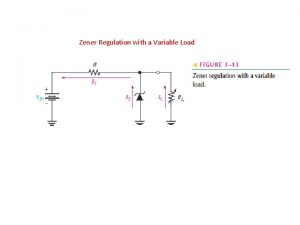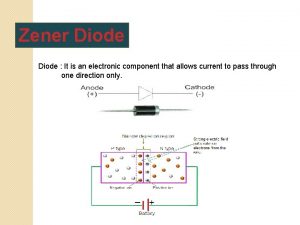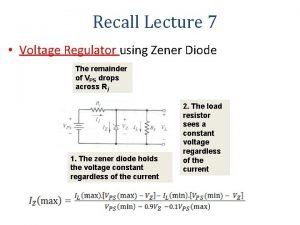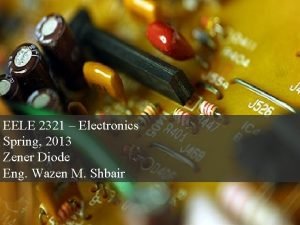1 3 1 Zener Diode Zener diode is




































- Slides: 36

1

3. 1 Zener Diode Zener diode is a p-n junction diode that is designed to operate in the reverse breakdown region. Two things happen when the reverse breakdown voltage (VBR) is reached: Fig. 3 -1: Zener diode symbol. Cathode (K) K + VZ IZ − Anode (A) A The diode current increases drastically. The reverse voltage (VR) across the diode remains relatively constant. In other words, the voltage across a zener diode operated in this region is relatively constant over a range of reverse current and nearly equal to its zener voltage (VZ) rating. 2 Fig. 3 -2: Zener diode voltage-curent (V-I) characteristic.

Inventor of Zener Diode Clarence Melvin Zener was a professor at Carnegie Mellon University in the department of Physics. He developed the Zener Diode in 1950 and employed it in modern computer circuits. 3

3. 1. 1 Zener Breakdown There are two types of reverse breakdown: 1. Avalanche breakdown. 2. Zener breakdown. Avalanche breakdown is a high-field effect that occurs when the electrostatic field strength associated with the p-n junction is strong enough to pull electrons out of the valence band within the depletion region. Zener breakdown is a type of reverse breakdown that occurs at relatively low reverse voltages. The n-type and p-type materials of a zener diode are heavily doped, resulting in a very narrow depletion region. Therefore, the electric field existing within this region is intense enough to pull electrons from their valence bands and create current at a low reverse voltage (VR). Note: Zener diodes with low VZ ratings experience zener breakdown, while those with high VZ ratings usually experience avalanche breakdown. 4

3. 1. 2 Breakdown Characteristics IZ The characteristic that indicates the ability of VZ VBR the zener diode to keep the reverse voltage across its terminals nearly constant makes VR the diode is useful as a voltage regulator. Zener knee current Four main characteristics of the zener diode are: Zener voltage (VZ) is the nominal zener voltage at the breakdown voltage. Zener knee current (IZK) is the minimum current required to maintain the diode in breakdown for the voltage regulation. Zener test current (IZT) is the current level at which the VZ rating of the diode is measured. Zener maximum current (IZM) is the maximum reverse current, which may not be exceeded. At this current level, the diode can work without being damaged or destroyed. ΔIR Zener test current IZK IZT IZM maximum Zener current ΔVR Fig. 3 -3: Reverse characteristic of a zener diode. 5

3. 1. 3 Ideal-and-Practical Zener Equivalent Circuits IF VR VZ VF IR Fig. 3 -4: Ideal model and characteristic curve of a zener diode in reverse breakdown. The constant voltage drop = the nominal zener voltage. Fig. 3 -5: Practical model and characteristic curve of a zener diode, where the zener impedance (resistance), ZZ is included. A change in zener current (ΔIZ) produces a small changes in zener voltage (ΔVZ). 6

3. 1. 4 Temperature Coefficient The zener voltage of a zener diode is very sensitive to the temperature of operation. The formula for calculating the change in zener voltage due to a change in temperature is (3 -1) where, VZ = nominal zener voltage at the reference temperature of 25 o. C. TC = temperature coefficient. T 1 = new temperature level. T 0 = reference temperature of 25 o. C. 3. 1. 4 Zener Power Dissipation and Derating The maximum current that may be carried by a given zener diode depends on both the zener voltage and the maximum dc power dissipation capability of the diode. The dc power dissipation of the zener diode is given by the formula, (3 -2)7

The maximum power dissipation of a zener diode is specified for temperature at or below a certain value (50 o. C, for example). Above the specified temperature, the maximum power dissipation is reduced according to a derating factor. The derating factor is expressed in m. W/o. C. The maximum derated power can be determined with the following formula: (3 -3) 8

3. 2 Zener Diode Applications The zener diode can be used as a type of voltage regulator for providing stable reference voltages. 3. 2. 1 Zener Regulation with a Varying Input voltage VOUT Fig. 3 -6: Zener regulation with a no-load. 9

For an ideal model of a certain zener diode, the minimum zener current (IZK) is specified on datasheet. However, the maximum zener current is not given on datasheet but can calculated from the maximum diode power specification, which is given on datasheet by using the equation: (3 -4) For the minimum zener current, the voltage across the resistor is determined by: (3 -5) Thus, the minimum input voltage that can be regulated by the zener diode, (3 -6) 10

For the maximum zener current, the voltage across the resistor is determined by: (3 -7) Thus, the maximum input voltage that can be regulated by the zener diode, (3 -8) 11

3. 2. 2 Zener Regulation with a Variable Load The zener diode maintains a nearly constant voltage across RL as long as the zener current is greater than IZK and less than IZM. Fig. 3 -7: Zener voltage regulation with a variable load When the output terminals of the zener regulator are open (RL = ∞) or a no-load condition, the load current (IL) = 0 and all of the current is through the zener. When a load resistor (RL) is connected, a part of the total current is through the zener and an other part through RL. As RL is decreased, the load current IL increases and IZ decreases. The zener diode continues to regulate the voltage until IZ reaches its minimum value, IZK. At this point IL 12 is maximum, and a full-load condition exists.

By using mathematically formula, when IZ is maximum, we obtain: (3 -9) thus, (3 -10) When IZ is minimum (IZ = IZK), so (3 -11) (3 -12) 13

3. 2. 3 Zener Regulation with a Variable Load In addition to voltage regulation applications, zener diode can be used in ac applications to limit voltage swings to desired levels. Part (a) shows a zener used to limit the positive peak of a signal voltage to the selected zener voltage. During the negative alternation, the zener acts as a forward-biased diode and limits the negative voltage to -0. 7 V. When the zener is turned around, as in part (b), the negative peak is limited by zener action and the positive voltage is limited to +0. 7 V. Two back-to-back zeners limit both peaks to the zener voltage ± 0. 7 V, as shown in part (c). During the positive alternation, D 2 is functioning as the zener limiter and D 1 is functioning as a forward-biased diode. During the negative alternation, the roles are reversed. 14 Fig. 3 -8.

3. 3 Varactor Diode Varactor is a type of p-n junction diode that operates in reverse bias. The capacitance of the junction is controlled by the amount of reverse bias. Varactor diodes are also referred to as varicaps or tuning diodes and they are commonly used in communication systems. Fig. 3 -9: Varactor diode symbol 3. 3. 1 Basic Operation The capacitance of a reverse-biased varactor junction is found as: (3 -13) where, C = the total junction capacitance. A = the plate area. ε = the dielectric constant (permittivity). d = the width of the depletion region (plate separation). Fig. 3 -10: Reverse-biased varactor 15 diode acts as a variable capacitor.

The ability of a varactor to act as a voltage-controlled capacitor is demonstrated in Fig. 3 -10: Varactor diode capacitance varies with reverse voltage. As the reverse-bias voltage increases, the depletion region widens, increasing the plate separation, thus decreasing the capacitance. When the reverse-bias voltage decreases, the depletion region narrows, thus increasing 16 the capacitance.

3. 3. 2 Varactor Application A major application of varactor is in tuning circuits, for example, VHF, UHF, and satelite receivers utilize varactors. Varactors are also used in cellular communications. When used in a parallel resonant circuit, as shown in Fig. 3 -11, the varactor acts as a variable capacitor, thus allowing the resonant frequency to be adjusted by a variable voltage level. Fig. 3 -11: A resonant band-pass filter. 17

C 1 prevents a dc path from potentiometer wiper back to the ac source through the inductor and R 1. C 2 prevents a dc path from cathode to the anode of the varactor through the inductor. C 3 prevents a dc path from the wiper to a load on the output through the inductor. C 4 prevents a dc path from the wiper to ground. R 2, R 3, R 4 and R 5 function as a variable dc voltage divider for biasing the varactor. The parallel resonant frequency of the LC circuit is (3 -14) where, L = the inductance of an inductor (H) C = the capacitance of a capacitor (F). 18

3. 4 Optical Diodes There are two popular types of optoelectronic devices: light-emitting diode (LED) and photodiode. 3. 4. 1 The Light-Emitting Diode (LED) LED is diode that emits light when biased in the forward direction of p-n junction. Anode Cathode (b) (c) Fig. 3 -12: The schematic symbol and construction features. 19

Fig. 3 -13: LED that are produced in an array of shapes and sizes. LED characteristics: characteristic curves are very similar to those for p-n junction diodes higher forward voltage (VF) lower reverse breakdown voltage (VBR). 20

The basic operation of LED is as illustrated in Fig. 3 -14: “When the device is forward-biased, electrons cross the p-n junction from the n-type material and recombine with holes in the p-type material. These free electrons are in the conduction band at a higher energy than the holes in the valence band. When recombination takes place, the recombining electrons release energy in the form photons. A large exposed surface area on one layer of the semiconductive material permits the photons to be emitted as visible light. ” This process is called electroluminescence. Various impurities are added during the doping process to establish the wavelength of the emitted light. The wavelength determines the color of visible light. Fig. 3– 15: Electroluminescence in a forward-biased LED. 21

LED Semiconductor Materials The color emitted by a given LED depends on the combination of elements used to produce the component. Some common element combinations are identified in Table 3 -1. TABLE 3 -1: Common LEDs Compound Forward Voltage (VF) Color Emitted Ga. As 1. 5 V Infrared (invisible) Al. Ga. As 1. 8 V Red Ga. P 2. 4 V Green Ga. As. P 2. 0 V Orange Ga. N 4. 1 V White Al. Ga. In. P 2. 0 V Amber (yellow) Al. Ga. In. N 3. 6 V Blue VF is measured at IF = 20 m. A in each case. 22

Current-Limiting Resistor When used in most practical applications, LED require the use of a series currentlimiting resistor, as shown in Fig. 3 -16 (a). The resistor ensures that the maximum current rating of the LED can not be exceeded by the circuit current. The amount of power output translated into light is directly proportional to the forward current, as indicated in Fig. 3 -16 (b) Fig. 3 -16: Basic operation of a LED. 23

The limiting resistor (RLIMIT) is determined using the following question: 24

Application The seven segment display is an example of LEDs use for display of decimal digits. Fig. 3 -17: The 7 -segment LED display. 25

3. 4. 2 The Photodiode is a p-n junction that can convert light energy into electrical energy. It operates in reverse bias voltage (VR), as shown in Fig. 3 -18, where Iλ is the reverse light current. It has a small transparent window that allows light to strike the p-n junction. The resistance of a photodiode is calculated by the formula as follows: Fig. 3 -18: Photodiode. 26

When its p-n junction is exposed to light, the reverse current increases with the light intensity as shown by the graph in Fig. 3 -19 expressed as irradiance (m. W/cm 2). When there is no incident light, the reverse current is almost negligible and is called the dark current. Fig. 3 -19: Typical photodiode characteristics. 27

Fig. 3 -20 illustrates that the photodiode is placed in the circuit in reverse bias. As with most diodes when in reverse bias, no current flows when in reverse bias, but when light strikes the exposed junction through a tiny window, reverse current increases proportional to light intensity. Fig. 3 -20: Operation of photodiode. 28

3. 5 Other Types of Diodes 3. 5. 1 The Schottky Diode A Schottky diode symbol is shown in Fig. 3 -21(a). The Schottky diode’s significant characteristic is its fast switching speed. This is useful for high frequencies and digital applications. It is not a typical diode in that it does not have a p-n junction. Instead, it consists of a doped semiconductor (usually n-type) and metal bound together, as shown in Fig. 3 -21(b). Fig. 3 -21: (a) Schottky diode symbol and (b) basic internal construction of a Schottky diode. 29

3. 5. 2 The Laser Diode The laser diode (light amplification by stimulated emission of radiation) produces a monochromatic (single color) light. Laser diodes in conjunction with photodiodes are used to retrieve data from compact discs. Fig. 3 -22: Basic laser diode construction and operation. 30

3. 5. 3 The PIN Diode The pin diode is also used in mostly microwave frequency applications. Its variable forward series resistance characteristic is used for attenuation, modulation, and switching. In reverse bias it exhibits a nearly constant capacitance. Fig. 3 -23: PIN diode 31

3. 5. 4 Current Regulator Diode Current regulator diodes keeps a constant current value over a specified range of forward voltages ranging from about 1. 5 V to 6 V. Fig. 3 -24: Symbol for a current regulator diode. 32

3. 5. 5 The Step-Recovery Diode The step-recovery diode is also used for fast switching applications. This is achieved by reduced doping at the junction. 3. 5. 6 The Tunnel Diode The tunnel diode has negative resistance. It will actually conduct well with low forward bias. With further increases in bias it reaches the negative resistance range where current will actually go down. This is achieved by heavily-doped p and n materials that creates a very thin depletion region. Fig. 3 -25: Tunnel diode symbol and characteristic curve. 33

3. 6 Troubleshooting Although power supply outputs generally use IC regulators, zener diodes can be used as a voltage regulator when less precise regulation and low current is acceptable. The meter readings of 15. 5 V for no-load check and 14. 8 V for full-load test indicate approximately the expected output voltage of 15 V. A properly functioning zener will work to maintain the output voltage within certain limits despite changes in load. Fig. 3 -25: Zener-regulated power supply test. 34

Case-1: Zener Diode Open In no-load check, output voltage is 24 V as shown in Fig. 3 -26(a). This indicates an open circuit between the output terminal and ground. Therefore, there is no voltage dropped between the filtered output of the power supply and the output terminal. In full-load check, output voltage is 14. 8 V due to the voltage-divider action of the 180 Ω series resistor and the 291 Ω load. The result for full-load check is too close to the normal reading to be reliable fault indication and thus, the no-load check is used to verify the problem. Figure 3 -26: Indications of an open zener. 35

Case-2: Incorrect Zener Voltage As indicated in Fig. 3 -27, no-load check that result in an output voltage greater than the maximum zener voltage but less than the power supply output voltage indicates that the zener has failed. The 20 V output in this case is 4. 5 V higher than the expected value of 15. 5 V. That additional voltage indicates the zener is faulty or the wrong type has been installed. Fig. 3 -27: Indication of excessive zener impedance. 36
 Difference between pn junction diode and zener diode
Difference between pn junction diode and zener diode Tvs diode vs zener
Tvs diode vs zener Zener diode is used as
Zener diode is used as Zener diode parameters
Zener diode parameters P-n junction diode as half wave rectifier
P-n junction diode as half wave rectifier Zener diode function
Zener diode function Peak inverse voltage
Peak inverse voltage Zener diode equations
Zener diode equations Zener diode junction
Zener diode junction Zener diode for led lights
Zener diode for led lights Advantages of zener diode
Advantages of zener diode Zener impedance formula
Zener impedance formula Shunt voltage regulator circuit
Shunt voltage regulator circuit Circuits with dependent sources
Circuits with dependent sources Diagraam
Diagraam Lambang diode
Lambang diode Silicon germanium diode
Silicon germanium diode Role diode zener
Role diode zener Special purpose diode
Special purpose diode Zener diode
Zener diode Zener diode
Zener diode Bias maju dan bias mundur
Bias maju dan bias mundur Equivalent circuit for zener diode
Equivalent circuit for zener diode Chất bán dẫn
Chất bán dẫn Zener effect
Zener effect Diode zener
Diode zener Hot carrier diode
Hot carrier diode Perbedaan dioda zener dan dioda biasa
Perbedaan dioda zener dan dioda biasa Aplicacion diodo zener
Aplicacion diodo zener Que es un integrado
Que es un integrado Ponte di graetz con zener
Ponte di graetz con zener Zona zener
Zona zener Zener dióda működése
Zener dióda működése Zener effect
Zener effect Solid state diode definition
Solid state diode definition Lm431
Lm431 Load line diode
Load line diode
